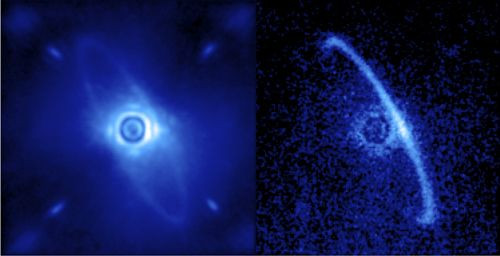Gemini Planet Imager ‘First Light’ Photos Released, Shows Planet Orbiting Beta Pictoris In ‘Exquisite Detail’ [PHOTOS]

The first photos from the world’s most advanced instrument for analyzing distant planets and stars have emerged.
The Gemini Planet Imager, an instrument 10 years in the making, is the first fully optimized planet imager deployed on one of the world’s largest telescopes -- the 8-meter Gemini South telescope in Chile. The $25 million camera had its “first light” on Nov. 11, 2013. Images from this event were released on Wednesday.
“There really hasn’t been anything quite like it,” Les Saddlemyer, a systems engineer with the National Research Council, who oversaw the Canadian phase of the camera’s construction, told the Globe and Mail.
The instrument captured the first-ever spectrum of the very young planet Beta Pictoris b. In polarization mode, the GPI also showed the light scattered by a disk of dust orbiting the young star HR4796A. Whereas older instruments would have been able only to capture the edges of the dust ring, the GPI was able to show its full circumference. The image took just 60 seconds to capture compared to hours other instruments would take to perform the same task, Space.com reports.

"Even these early first-light images are almost a factor of 10 better than the previous generation of instruments. In one minute, we were seeing planets that used to take us an hour to detect,” Dr. Bruce Macintosh, a physicist with Stanford University and the Lawrence Livermore National Laboratory in California, said.
More than 1,000 exoplanets have been detected, but nearly all of them have never been seen. Other planet imaging systems can capture planets only the size of Jupiter or larger. NASA’s Kepler space telescope is able to detect small planets but does not see them directly.
"Almost nothing is known about the composition of the planets Kepler is seeing," MacIntosh said in a news conference Wednesday at the 223rd meeting of the American Astronomical Society in Washington. "Direct imaging is offering a way to do that."
The GPI is the best camera at creating an image of a distant star, not by inference, but by locking into a star and subtracting light from an adjacent planet. The imager should be able to capture images of planets from other solar systems – located up to 230 light years away.
“We can actually see them, which means we can look at what they’re made of much more easily,” Quinn Konopacky, a member of the GPI team, said.
The GPI may soon see a companion later this year. A similar camera called SPHERE now being built by the European Southern Observatory is expected to go online in 2014.
"GPI represents a critical step in the road toward understanding how planetary systems form and develop," Dmitry Savransky of the Lawrence Livermore National Laboratory, who worked on the integration and testing of GPI, said in a statement. "While broad survey missions, such as Kepler, have revealed the variety of planets that exist in our galaxy, GPI will allow us to study a few dozen planets in exquisite detail."
© Copyright IBTimes 2025. All rights reserved.




















